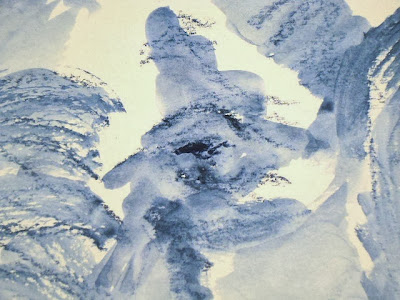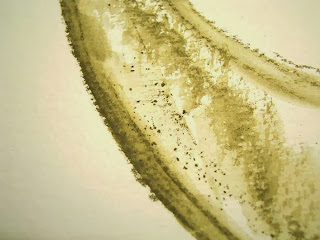A few days ago, I went to a demonstration of Derwent and Conté products. I received a set of Graphitint pencils at the demonstration, but I liked the big blocks of graphite just as much. So I bought some.
There are many things you can do with these. You can sketch with them, create large swaths of colour, wet the pigment to paint with it, sprinkle dust onto a wet surface, and other stuff I haven't yet discovered.
For today's elephant, I didn't have much time, so I decided I'd just make some kind of big, bold elephant with these blocks. I used big 16 x 20 (40.5 x 50.8 cm) sheets of paper, which is actually something I rarely do. The prospect of dealing with all that blank space generally fills me with dread.
I used the following photograph to guide my drawing.
 |
| Asian elephant. Photo: WWF-Indonesia/Samsul Komar Source: http://worldwildlife.org/species/asian-elephant |
I began by sketching the general outline. I was going to do a faint outline, but got carried away. I really like these graphite blocks, and I never work big, so it was rather freeing.
Since this is a watersoluble medium, I decided to use a water to make the drawing come to life. This was also fun, because the pigment reacts beautifully to the water, making really saturated colours. I also worked fairly loosely, which is a bit unusual for me.
After I had done the initial painting on this, I stared at it for a few minutes, trying to decide if I was finished or not. Something this easy never feels quite finished to me, and if I were working carefully and precisely, I would do far more to it. But I decided to leave well enough alone, as I liked enough things about this drawing that I didn't want to risk making a mess of it.
Since this was so easy, I decided to do another one, using the same image, but a different colour. I wasn't entirely happy with my interpretation of the photograph the first time, so this was an opportunity to try again.
I sketched the elephant again, this time liking the form a little better.
Using a fairly saturated paintbrush, I moved the pigment around.
It looked pretty good to me, but I thought I'd also try wetting some of the areas, grating the graphite block onto the wet surface to make it bloom. I had this handy-dandy block grater, made specifically for this purpose, but you could probably also use something like a nutmeg grater or a piece of metal window screen.
Liking the effect right away, I repeated it in a few other parts of the drawing. Then I decided to leave well enough alone.
I liked both of these, for different reasons. I also like these blocks, like the grater, and actually enjoyed drawing big and bold for a change. This felt more like play than any drawing I've done yet, so I'll definitely be trying this again sometime.
Elephant Lore of the Day
White elephants found in the forests of Thailand are regarded not as animals, but as honorary human beings. Before being accorded this status, they must be officially recognized by royal priests; but, once recognized, they are given the rank of high courtier. Their names are preceded by the title phra-sarith which means "excellent white one."As late as the early twentieth century, when a white elephant arrived in the capital, the King of Thailand would attend prayers of welcome, which were chanted by ten priests. On the following morning, the King would also be on hand for the ceremonial bathing of the elephant, as well as a Brahmin ceremony intended to bring good luck. At this time, the King would also give the elephant its name.
In the evening, white elephants are sung to sleep by Brahmin priests. In earlier days, a singer and master musician would serenade the elephant to sleep, and the last musician to play for a white elephant considered it a great honour.
As mentioned in my original Elephant a Day blog, "white elephant" as a synonym for "thing I don't want" is a concept that originates in Thailand. Because many Asian countries venerated albino elephants—meaning that they required special housing, food and care—they were expensive to keep. One of Thailand's kings thus devised an interesting way of punishing nobles who crossed him. Instead of tossing the offender in prison, he would present them with a white elephant: a gift sure to result in financial ruin.
To read more about white elephants, click here.
To Support Elephant Welfare
Boon Lott's Elephant Sanctuary (Thailand)Wildlife SOS (India)
The Elephant Sanctuary (Tennessee)
David Shepherd Wildlife Foundation















No comments:
Post a Comment